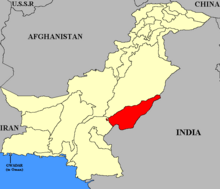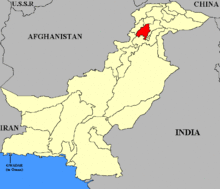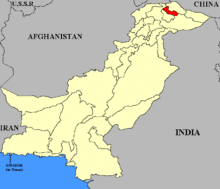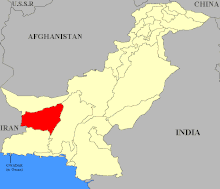Princely states of Pakistan
 |
| This article is part of the series |
| Former administrative units of Pakistan |
|---|
The Princely States of Pakistan (Urdu: پاکستان کی نوابی ریاستیں; Sindhi: پاڪستان جون نوابي رياستون) were princely states of the British Indian Empire which acceded to the new Dominion of Pakistan between 1947 and 1948, following the partition of British India and its independence.
At the time of the withdrawal of British forces from the subcontinent on 15 August 1947, West Pakistan was less than half of its ultimate size. The States were incorporated following a year of negotiations and interventions. [1][2]
Options of the Princes
[edit]
Amir of Bahawalpur, as used in 1949
| Princely state |
|---|
| Individual residencies |
| Agencies |
|
| Lists |
With the withdrawal of the British from the Indian subcontinent, in 1947, the Indian Independence Act provided that the hundreds of princely states which had existed alongside but outside British India were released from all their subsidiary alliances and other treaty obligations to the British, while at the same time the British withdrew from their treaty obligations to defend the states and keep the peace. The rulers were left to decide whether to accede to one of the newly independent states of India or Pakistan (both formed initially from the British possessions) or to remain independent outside both.[3] As stated by Sardar Patel at a press conference in January 1948, "As you are all aware, on the lapse of Paramountcy every Indian State became a separate independent entity."[4]
Only two rulers acceded to Pakistan in the first month of its independence, August 1947, while the others considered what to do, but most of those states with a Muslim majority population had acceded to Pakistan within a year, prompted in several cases by the Indo-Pakistani War of 1947.
The Instruments of Accession made available for the rulers to sign transferred only limited powers to the Dominion of Pakistan, namely external relations, defence, and communications; in most cases signing was believed to leave the states in the position they had under the suzerainty of the British Crown. The Wali of Swat commented that the states' accession "did not change very much".[5] However, within a generation all of the princely states had lost their internal autonomy. The last to fall were Hunza and Nagar, in October 1974.[6]
Attempts by Junagadh and Bantva Manavadar to accede
[edit]The princely state of Junagadh, a coastal state on the Kathiawar peninsula, had a mostly Hindu population but a Muslim ruler, Muhammad Mahabat Khan III, and in August 1947 he decided to accede to Pakistan, the first ruler of a state to do so. The Nawab's dewan, Sir Shah Nawaz Bhutto, delivered the Instrument of Accession to Jinnah in person, and on 13 September Jinnah accepted the accession. However, some of the Hindu subjects who formed the majority of the population revolted, and seeking to force the Nawab of Junagadh to change his decision, India imposed a blockade on the state.[7] On 8 November, after giving up on all hope of assistance from Pakistan, Bhutto asked the Indian government to take over the administration of the state as a temporary measure to restore order.[8] This arrangement was pending a final settlement through negotiations and did not mean that Junagadh had acceded to India.[9] The Government of India installed a governor and arranged a referendum on the status of the state, which took place on 20 February 1948 and voted overwhelmingly for union with India.[10] This led to the integration of Junagadh into India.[11] India maintained that it had not invaded Junagadh, but had taken it over only after the Nawab's government had completely collapsed.[12]
Ghulam Moinuddin Khanji, Khan of Bantva Manavadar, a subordinate or vassal state of Junagadh, also signed an accession to Pakistan on 24 September 1947. The Indian police invaded Manavadar on 22 October, and the Khan was arrested. Following a plebiscite, the state was merged with the newly federated state of Saurashtra on 20 February 1949. The Khan was released as a result of the Liaquat–Nehru Pact of 8 April 1950. He lived in Karachi from 1951, where he continued to be recognized as a prince. He became president of the Pakistan Hockey Federation and died in 2003.[13]
Princely states of Pakistan in order of accession
[edit]Bahawalpur
[edit]
On 3 October 1947, after some delay, the Nawab (or Ameer) of Bahawalpur, Sadeq Mohammad Khan V, acceded his state to Pakistan, becoming the first ruler to do so successfully.[14][15] As tens of thousands of Muslim refugees flooded into the state from the new India, the Ameer of Bahawalpur Refugee Relief and Rehabilitation Fund was instituted to provide for their relief. In 1953, the Ameer of Bahawalpur represented Pakistan at the coronation of Queen Elizabeth II. In 1955 he signed an agreement with the Governor-General of Pakistan, Malik Ghulam Muhammad, under which Bahawalpur became part of the province of West Pakistan, with effect from 14 October 1955, and the Ameer received a yearly privy purse of 32 lakhs of rupees, keeping his titles.[16]
Khairpur
[edit]
The state of Khairpur also acceded to Pakistan on 3 October 1947.[14][17] George Ali Murad Khan (born 1934), who from 19 July 1947 to 14 October 1955 was the last Amir (or Nawab) of Khairpur, was a minor for much of his reign, so it was a Regent, Mir Ghulam Hussain Khan Talpur Baluch, who acceded to Pakistan on his behalf.[18]
In 1950 the Amir introduced a form of democracy, with universal adult franchise. In 1955 the state was integrated into Pakistan.[17] The royal privileges of the Amir were abolished in 1972.
The last Amir is one of the few surviving princes.[19]
Chitral
[edit]
The Mehtar of Chitral, Muzaffar-ul-Mulk (1901–1949), stated his intention to accede to Pakistan on 15 August 1947.[20] However, his formal accession was delayed until 6 October.[14][5] He died in January 1949. His son, Saif-ur-Rahman (1926–1954), had been exiled by the Government of Pakistan and a board of administration composed of Chitrali noblemen was to govern the state in his absence. In October 1954 Saif-ur-Rahman was allowed to return from exile to take charge of Chitral, but he died in a plane crash on the way home, leaving his four-year-old son Mohammad Saif-ul-Mulk Nasir (1950–2011) as ruler. His uncle, Shahzada Asad ur-Rahman, acted as Regent until he came of age and was invested with the full powers of Mehtar at Chitral Fort in May 1966.[21]
On 28 July 1969, President Yahya Khan announced the full integration of the states of Chitral, Dir, and Swat into Pakistan,[22] and the dispossessed young ruler, then aged nineteen, agreed to take up a diplomatic career. He joined the Foreign Service in 1973 and served as First Secretary at Ankara, 1974–1979, as Deputy Chief of Protocol in the Ministry of Foreign Affairs, 1979–1985, and as Assistant Consul-General in Hong Kong, 1985–1989.[21]
Swat
[edit]
The Wāli of Swat, Miangul Abdul Wadud, acceded his state to Pakistan on 3 November 1947.[14] The last Wali, Miangul Jahan Zeb (1908–1987), continued to exercise absolute rule until Pakistan took control, when on 28 July 1969 Yahya Khan announced the full integration of the states of Swat, Chitral, and Dir into Pakistan.[22][23]
Hunza
[edit]Hunza was a small princely state to the north of Jammu and Kashmir, and had been subject to the suzerainty of the Maharajah of Kashmir since 1891. In 1931 its population was reported as 13,241.[24] Having once been under Chinese protection, after the departure of the British from the subcontinent in August 1947 Hunza received approaches from the Republic of China, which wished Mir to return to Chinese protection. However, on 3 November 1947, the Mir of Hunza, Mohammad Jamal Khan (1912-1976), who had been ruler only since 1946, sent a telegram to Jinnah stating that he wished to accede his state to Pakistan.[25] This action came one week after the decision by Hari Singh, Maharajah of Kashmir, to accede to India, following the invasion by Pashtun Mehsud tribals, backed by Pakistani paramilitary forces,[26] in October 1947 under the code name "Operation Gulmarg" to seize Kashmir. On 27 October Indian Army troops had moved into Kashmir. Hunza's formal accession took place on 18 November.[27] On 25 September 1973, following local protests, the Mir's rule came to an end when Zulfikar Ali Bhutto, Prime Minister of Pakistan, abolished the Mir's government and annexed the state to the Northern Areas of Pakistan, under the federal government. Two years after his forced abdication the Mir died.[citation needed]
Nagar
[edit]
Nagar was another small valley state to the north of Kashmir and shared the language and culture of Hunza.[27] In 1931 it had a population of 13,672, much the same as that of Hunza.[24] On 18 November 1947 its ruler, Shaukat Ali Khan (1917–2003), who had come to the throne in 1940, joined his neighbour in acceding to Pakistan.[27] They did this after resisting considerable pressure from Hari Singh of Jammu and Kashmir to enter into new subsidiary alliances with him.[28]
In 1968 Syed Yahya Shah, a politician of the valley, demanded civil rights from the Mir of Nagar. On 25 September 1973, not long after the Pakistan People's Party under Zulfiqar Ali Bhutto had come to power, the new government forced the last Mir of Nagar, Brigadier Shaukat Ali Khan, to abdicate his power, as with the Mir of Hunza, and like Hunza, Nagar was merged into the Northern Areas, although the Mir of Nagar was left with some of his purely ceremonial role.[29]
Amb
[edit]
On 31 December 1947, Muhammad Farid Khan, Nawab of Amb, acceded to Pakistan.[14][30] Amb continued to be an autonomous state within Pakistan until 1969, when following the death of the Nawab it was incorporated into the North West Frontier Province (now known as Khyber-Pakhtunkhwa). In 1971 recognition of the royal status of the Nawabs by the Government of Pakistan came to an end.
A small state, in 1958 Amb was reported to have an area of 1,520 square kilometres (585 square miles) and a population of 48,656.[31]
Phulra
[edit]
Phulra was a khanate near Amb, with a population of about 8,000 and an area of only 93 square kilometres (36 square miles).[31] Almost all of its people lived in ninety-eight villages.[32] Its last Khan, called Nawab abdul Latif khan. In 1949 the khanate came to an end when it was merged into the North West Frontier Province.[33]
Dir
[edit]
The Nawab of Dir, Sir Nawab Shah Jahan Khan, sent troops to support Pakistan in the First Kashmir War of 1947, and he signed an instrument of accession to Pakistan on 8 November, but it was not until 8 February 1948 that his state's accession was accepted by Jinnah as Governor-General.[14][30] In 1961 Yahya Khan exiled Jahan Khan and replaced him as Nawab with his son Mohammad Shah Khosru Khan, who was a Major General in the Pakistan Army, but the real control passed to the state's Political Agent. On 28 July 1969, Yahya Khan announced that the states of Dir, Chitral, and Swat were being incorporated into Pakistan.[22]
Las Bela
[edit]
Las Bela's ruler Ghulam Qadir Khan (1920–1988) acceded to Pakistan on 7 March 1948, and the accession was accepted by Pakistan on 17 March.[14][34] The state was a member of the Baluchistan States Union from 3 October 1952 to 14 October 1955, but it retained its internal autonomy. That came to an end in 1955, when Las Bela was incorporated into the new West Pakistan province and became part of the Kalat division. In 1962, Las Bela was detached from West Pakistan and merged with the Federal Capital Territory to form Karachi-Bela. In 1970, it became the Lasbela District of the new province of Balochistan.
Kharan
[edit]
With an area of 47,940 square kilometres (18,508 square miles) and a population reported in 1951 as 33,833,[35] Kharan was one of the princely states of Balochistan which retained some degree of their independence for several years. Its last Nawab was Habibullah Khan Nausherwani a Baloch chief (1897–1958), who was in power from 1911 until 1955.[36]
The state acceded to Pakistan on 17 March 1948, which was accepted on the same day.[14] On 21 March 1948, the rulers of Kharan, Makran, and Las Bela all announced that they were acceding their states to the Dominion of Pakistan.[34]
Makran
[edit]
Also on 17 March 1948, Makran acceded to Pakistan,[14][34] and on 3 October 1952 it formed the Baluchistan States Union with Kalat, Kharan and Las Bela. Makran was dissolved on 14 October 1955, when it was merged into the province of West Pakistan. In 1970, the area of the former state was organized as the Makran District (later the Makran Division) of the province of Baluchistan.
Khanate of Kalat
[edit]
The Khanate of Kalat, which covered the substantial area of 139,850 km2 (53,995 sq mi), was reported in 1951 to have a population of 253,305.[35] It remained fully independent from 15 August 1947 until 27 March 1948, when its ruler, Ahmad Yar Khan (1904–1979), finally acceded to Pakistan. On 3 October 1952 the state of Kalat entered into the Baluchistan States Union with three neighbouring states, Kharan, Las Bela, and Makran, with the Khan of Kalat at the head of the Union with the title of Khan-e-Azam. The Khanate came to an end on 14 October 1955, when it was incorporated into West Pakistan.[37]
On 20 June 1958, Mir Sir Ahmad Yar Khan Ahmedzai, the Khan of Kalat, declared Baluchistan revolt.[38] On 6 October 1958, the Balochistan police captured the Kalat Palace and arrested the Khan for sedition. The next day, Iskandar Mirza declared martial law, which led to disturbances in Balochistan lasting about a year.[39] The Khan was eventually forgiven and released.
See also
[edit]References
[edit]- ^ Yaqoob Khan Bangash, A Princely Affair: The Accession and Integration of the Princely States of Pakistan, 1947-1955 (Oxford University Press, 2015), introduction.
- ^ Bangash, Yaqoob Khan (14 August 2022). "Winning Over The Princely States". DAWN.COM. Retrieved 24 July 2023.
- ^ Ishtiaq Ahmed, State, Nation and Ethnicity in Contemporary South Asia (London & New York, 1998), p. 99
- ^ R. P. Bhargava, The Chamber of Princes (Northern Book Centre, 1991) p. 313
- ^ a b Axmann, Back to the Future (2008), p. 273.
- ^ Lindsay Brown, Paul Clammer, Rodney Cocks, Pakistan & the Karakoram Highway (2008), p. 296
- ^ "Junagadh" in John Mcleod, Historical Dictionary of the British Empire, Volume 1, p. 614: "In order to compel Mahabatkhanji to reverse his accession, India sent troops to the surrounding states and imposed a blockade"
- ^ Achyut Yagnik, Shaping of Modern Gujarat (Penguin UK, 2005, ISBN 8184751850)
- ^ Cheema, Iqtidar Karamat (2006). Quaid-i-Azam Mohammad Ali Jinnah as Governor-General of Pakistan. Pakistan Study Centre, University of the Punjab. p. 42. ISBN 978-969-8181-03-1.
- ^ Srinath Raghavan, War and Peace in Modern India (2010), p. 63
- ^ Rajmohan Gandhi, Patel: A Life (India: Navajivan, 1992), p. 292
- ^ Accession of Junagadh: Farce of History, revisitingindia.com, 28 Aug 2013.
- ^ KARACHI: Nawab Moinuddin laid to rest, dawn.com, 15 Feb 2003, accessed 29 October 2020
- ^ a b c d e f g h i Wilcox, Pakistan: The Consolidation (1963), p. 82
- ^ Umbreen Javaid, Politics of Bahawalpur: From State to Region, 1947-2000 (2004), p. 115
- ^ The All Pakistan Legal Decisions, vol. 30, part 2 (1978), p. 1,171
- ^ a b Siddiqi, The Politics of Ethnicity in Pakistan (2012), p. 130.
- ^ Pakistan Constituent Assembly Debates: Official report, vol. 1 (issues 1-1950, 1947), p. 152
- ^ Roger D. Long, Gurharpal Singh, Yunas Samad, Ian Talbot, State and Nation-Building in Pakistan: Beyond Islam and Security (Routledge, 2015, ISBN 9781317448204) pp. 94–95
- ^ Kuldip Singh Bajwa, Jammu and Kashmir War, 1947-1948 (2003), p. 141
- ^ a b Brief History of Ex Mehter Chitral HH Prince Saif ul Mulk Nasir Archived 29 October 2013 at the Wayback Machine, chitraltimes.com, accessed 31 October 2020
- ^ a b c Muhammad Sher Ali Khan, The elite minority, the princes of India (1989), p. 98: "On 28 July 1969, President Yahya Khan announced in a broadcast to the nation... that his administration had decided that the time has come to merge the states of Chitral, Dir and Swat in West Pakistan"
- ^ Brown, Clammer, & Cocks (2008), p. 209
- ^ a b Census of India, 1931, Volume XXIV: Jammu & Kashmir State, Part 1 – Report (India Census Commissioner Manager of Publications, 1933), p. 59
- ^ Z. H. Zaidi, ed., Jinnah Papers: The states: Historical and Policy Perspectives and Accession to Pakistan, vol. VIII (Quaid-i-Azam Papers Project, Government of Pakistan, 2003), p. 113
- ^ Haroon, Sana (1 December 2007). Frontier of faith: Islam in the Indo-Afghan borderland. Columbia University Press. pp. 179–180. ISBN 978-0-231-70013-9. Retrieved 26 February 2012.
- ^ a b c Pakistan Horizon, vol. 56, Issues 1-2, p. 57: "Hunza and Nagar acceded to Pakistan on November 18, 1947, but the northern regions have not been merged into Pakistan proper, pending the determination of the status of Jammu and Kashmir."
- ^ William Brown, Gilgit Rebellion: The Major Who Mutinied Over Partition of India (2014), pp. 66–68
- ^ Pakistan Pictorial Issue 1 (Pakistan Publications, 1973), p. 8: "The Rajas of Punial, Ishkoman, and Gupis, as also the Mir of Nagar, have been allowed to retain their ceremonial rights but the economic privileges, like levy of taxes for the entertainment of their guests, and other such, have been cancelled."
- ^ a b Z. H. Zaidi, CHRONOLOGY OF ACCESSION OF STATES TO PAKISTAN in Quaid-i-Azam Mohammad Ali Jinnah Papers: The States (Quaid-i-Azam Papers Project, 1993), p. xxxix
- ^ a b Amiya Ranjan Mukherjee, Current Affairs (1958), p. 337
- ^ Memoranda on the Indian States (Published by Authority, 1939), p. 215
- ^ Sir Terence Creagh Coen, The Indian Political Service: A Study in Indirect Rule (1971), p. 144
- ^ a b c Siddiqi (2012), p. 60: "The rulers of the states of Kharan, Makran and Lasbela announced their decision to join the Pakistan dominion on 21 March 1948 and their respective rulers signed the official documents."
- ^ a b Joseph Whitaker, Whitaker's Almanack 1951, vol. 83 (1951), p. 754: "the following States have also acceded to Pakistan : ]Kalat, area 53,995 square miles [139,850 square kilometres], pop. 253.305; Kharan, area 18,508 square miles [47,940 square kilometres], pop. 33,83a; Las Best, 7,043 square miles [18,240 square kilometres], pop 69,067; The North West Frontier States of Amb, Chitral, Dir."
- ^ M. Epstein, ed., The Statesman's Year-Book: Statistical and Historical Annual of the States of the World for the Year 1942 (1942), p. 166; West Pakistan District Gazetteers: Kharan (Printed at the West Pakistan Government Press, 1966), pp. 30–32
- ^ Farhan Hanif Siddiqi, The Politics of Ethnicity in Pakistan: The Baloch, Sindhi and Mohajir Ethnic Movements (Routledge, 2012), pp. 58–62
- ^ James Minahan, Encyclopedia of the Stateless Nations: A-C, vol. 1 (Greenwood Publishing, 2002, ISBN 978-0313321092), p. 258
- ^ Mohammed Yousuf, Balochistan Tango Archived 27 May 2008 at the Wayback Machine at despardes.com
Bibliography
[edit]- Martin Axmann (2008), Back to the Future: The Khanate of Kalat and the Genesis of Baloch Nationalism, 1915–1955, Oxford University Press, ISBN 978-0-19-547645-3
- Bangash, Yaqoob Khan (2015), A Princely Affair: The Accession and Integration of the Princely States of Pakistan, 1947–1955, Oxford University Press, USA, ISBN 978-0-19-906649-0
- Bangash, Y. K. (2015), "Constructing the state: Constitutional integration of the princely states of Pakistan", in Roger D. Long; Gurharpal Singh; Yunas Samad; Ian Talbot (eds.), State and Nation-Building in Pakistan: Beyond Islam and Security, Routledge, pp. 76–100, ISBN 978-1-317-44820-4
- Behera, Navnita Chadha (2007), Demystifying Kashmir, Pearson Education India, ISBN 978-8131708460
- Copland, Ian (February 1991), "The Princely States, the Muslim League, and the Partition of India in 1947", The International History Review, 13 (1): 38–69, doi:10.1080/07075332.1991.9640572, JSTOR 40106322
- Copland, Ian (2005), State, Community and Neighbourhood in Princely India, c. 1900–1950, Palgrave Macmillan, ISBN 0230005985
- Siddiqi, Farhan Hanif (2012). The Politics of Ethnicity in Pakistan: The Baloch, Sindhi and Mohajir Ethnic Movements. Routledge. ISBN 978-1-136-33697-3.
- Wilcox, Wayne Ayres (1963), Pakistan: The Consolidation of a Nation, Columbia University Press, ISBN 978-0-231-02589-8
